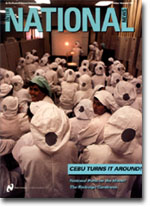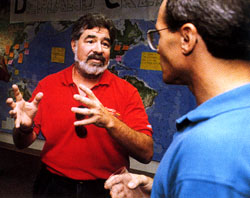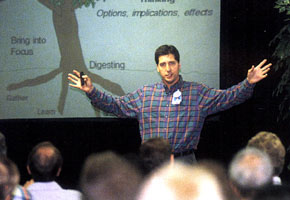
National Is Redesigning For Greatness
InterNational News - October 1994 - National Semiconductor
A division's fabrication plant faces low-cost competition. Another organization's structure prevents it from working closely with external customers. Yet another division is losing its technology leadership as it struggles with processes that hinder making great products quickly.
This article was featured in InterNational News. Sound familiar? National and many other companies have concerns similar to the ones mentioned here. To achieve greatness, companies must continually examine how they do business.
National is changing. One of the change processes National uses is "redesign." It's shown on our Vision in big red letters, and it's being used to bring the company closer to our customers.
"To meet our goal of becoming a $10 billion company, we must work differently," says Joe Fiorelli, who has a Ph.D. in Organizational Design and Development and is one of National's internal redesign consultants in the Business Systems Consulting Group. "The redesign process will help us become more effective to achieve our goals," he adds.
Why is so much effort being dedicated to organizational redesign? The answer is that employees involved are focusing on new ways to design their jobs and groups to be more effective at meeting our customers' needs. They're looking for new markets, ways to work more closely with our customers, and methods for bringing the right products to market faster. They're also studying other companies to find out how similar issues are solved. For some organizations it's a long, and sometimes painful, process.
You're probably asking yourselves, "How will a redesign affect my job or the way I work?" National's redesigns will have a noticeable effect on some employees, and with time many of us will be working differently. Data Management Division and Analog, the two largest product groups, will have many details of their redesigns worked out by year's end. Human Resources and the International Business Group's Americas Division redesigns are in the implementation stage.
But a redesign is an ongoing transformation, unlike a reorganization where the result is a little more than a new organization chart. Redesign success will be measured by how the company grows.
A good redesign process requires employee empowerment, which is why it involves hundreds of employees at National. Mark Richards, a design engineer and a member of the Analog redesign team, likes it this way: "It's the employees who know the changes that need to be made."
A well executed redesign process will be vital to our success. As a redesign consultant said, "Organizations are perfectly designed to get the results they get."
Here's a brief look at redesigns in Analog; Data Management Division; International Business Group, Americas Division and Southeast Asia; and Human Resources.
Analog
The Analog redesign began in January 1993. By October of the same year, the redesign team organized around markets (single and broad-based) and business processes with the goal of achieving the Analog Vision.
Analog completed the first stage of its implementation by dividing into two divisions: Analog Products; Bob Whelton, vice president and general manager; and Analog Mixed-Signal Systems, Keith Jackson, vice president and general manager. The top 90 positions in Analog were also filled through a self-selection process.
Peter Himes, leader of the Analog Strategy Development Team, explains the redesign process at an Analog Sharing Rally.Now Analog is studying its four core business processes and their linkages and working on a structure that aligns with Analog's Vision. Says Peter Himes, director of Analog strategic planning, "Our goal is to address the fundamental aspects of our business environment that affect how we view our work - our behaviors and feelings about roles and the attributes of our functional and group responsibilities - so that we maximize the percentage of our time spent on truly competitive work."
Data Management Division (DMD)
DMD began its redesign in August, with cross-functional team search conferences to find new business opportunities. DMD is a viable business, but the competitive nature of its business means that "we must look to become a great organization," says Wayne Carlson, division vice president and general manager.
On of six "givens," as DMD called them, is revenue growth two times the current plan, or $2 billion by the year 2000. The division redesign is selecting strategic markets to support its goal, as well as strategic partnership for product innovation, technology development, and more flexible manufacturing capabilities.
International Business Group (IBG)
Americas Division. IBG Americas changed its organization to align itself more closely to its customers in the strategic market segments. Seven customer-centered business units were formed, each aligned to a specific subset of our customer base. Each unit has a full complement of sales, marketing, applications, and planning personnel. Strategic segments covered by these include: Automotive, Mass Storage, Military/Aerospace, Networking, Personal Systems, and Telecommunications. The Geographic Business Unit, the seventh customer-centered unit, covers all other original equipment manufacturer accounts and distribution.
The business management activities of each product line will be managed by the Product Business Unit. Activities include price and supply line management, and financial planning and forecasting. Ernie Macintyre, vice president of the Product Business Unit, says, "Our group's focus on our internal customers allows us to provide better service to the needs of the market on behalf of the product lines."
Tricia Diller, Analog Business Planning Director, accepts input during the Analog Sharing Rally.Southeast Asia. "We started in December 1992 to establish an overview of the changes we needed to make," says S.W. Yeo, team leader. That team created a Vision of the market environment and challenges for the next five years. The redesign recently finished implementation planning.
Human Resources (HR)
HR creates competitive advantage though our people and processes. To enhance its Vision, HR will be more strategic, operating as business partners, actively participating in key business councils, and as Bob MacLean, vice president of HR says, "developing methods of supporting but not owning the manager-employee relationship." A Service Center where employees can receive basic HR services will be created. By transferring routine responsibilities to HR Service Centers, HR generalists can be more involved in important business matters and will be better able to serve employees to enhance "human capability development."





